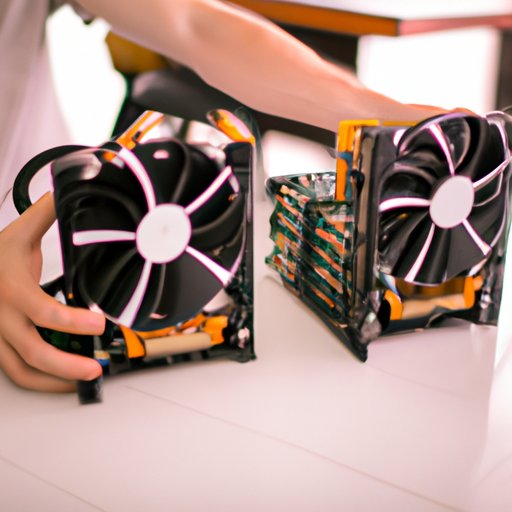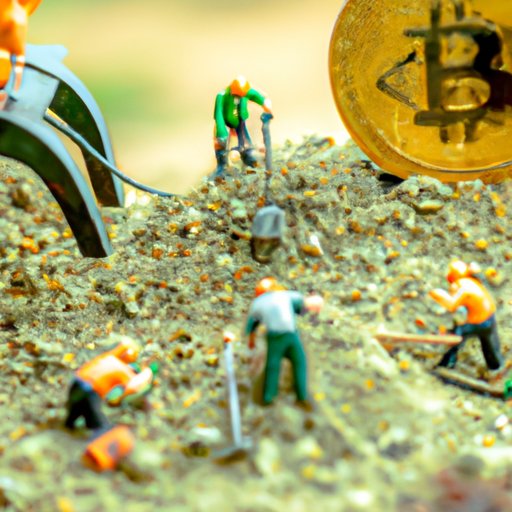Introduction
Bitcoin mining is the process of creating new Bitcoins by solving complex mathematical problems. The process involves verifying and adding transactions to the public ledger, known as the blockchain, and is done by powerful computers that run the Bitcoin network. This article will explore how does bitcoin mining work and the economics behind it.
Overview of Bitcoin Mining Process
The purpose of Bitcoin mining is to secure the network and process transactions on the blockchain. Miners are rewarded for their efforts with new Bitcoins and transaction fees. The process involves verifying and adding transactions to the public ledger, known as the blockchain, and is done by powerful computers that run the Bitcoin network.
Explaining the Role of Miners in the Network
What is a Miner? A miner is an individual or group of individuals who use specialized hardware and software to solve complex mathematical problems and create new blocks of transactions on the blockchain. They are rewarded with newly created Bitcoins and transaction fees.
How Does Mining Work?
Mining involves verifying and adding transactions to the public ledger, known as the blockchain. Miners compete to solve complex mathematical problems using specialized hardware and software. When a miner solves a problem, they receive a reward in the form of new Bitcoins and transaction fees. The difficulty of the mathematical problems increases as more miners join the network, making it harder to solve them.
Benefits of Mining
Mining is beneficial for several reasons. It provides security for the network by verifying and adding transactions to the blockchain. It also helps to create new Bitcoins and maintain the integrity of the network. Additionally, miners are rewarded for their efforts with new Bitcoins and transaction fees, which can be used to purchase goods and services.

Describing the Bitcoin Mining Hardware
In order to mine Bitcoin, miners need specialized hardware and software. The most popular type of hardware is Application-Specific Integrated Circuit (ASIC) miners, which are designed specifically for Bitcoin mining. These miners are more efficient than other types of hardware due to their low power consumption and high hash rates. Additionally, miners need to have access to a computer with a reliable internet connection in order to connect to the Bitcoin network.
Calculating Mining Profitability
When selecting mining hardware, miners should consider their electricity costs and the current difficulty of the Bitcoin network. The profitability of mining depends on these factors, as well as the price of Bitcoin. Miners should calculate their expected return on investment before investing in any mining hardware.
Analyzing the Difficulty Adjustment and Block Rewards
The difficulty of the mathematical problems that miners must solve increases as more miners join the network, making it harder to solve them. To ensure that a steady flow of new Bitcoins are created, the difficulty of the mathematical problems is adjusted every 2016 blocks. Additionally, miners are rewarded for their efforts with new Bitcoins and transaction fees, which are paid out in the form of a block reward.

Examining the Economics of Bitcoin Mining
The cost of mining depends on several factors, such as the type of hardware used, the electricity costs, and the current difficulty of the network. Additionally, the profitability of mining depends on the price of Bitcoin. Miners should calculate their expected return on investment before investing in any mining hardware. Additionally, miners should consider the risks associated with mining, such as the risk of the value of Bitcoin dropping or the risk of being hacked.

Exploring the Future of Bitcoin Mining
As the Bitcoin network grows, the difficulty of mining increases, making it harder for miners to turn a profit. Additionally, the increasing cost of electricity and competition from other miners makes it difficult for miners to remain profitable. To address these issues, miners are exploring potential solutions, such as switching to renewable energy sources and pooling resources with other miners.
Conclusion
This article explored how does bitcoin mining work, looking at the process, economics, hardware, difficulty adjustment, block rewards, and potential solutions to challenges faced by miners. By understanding the process and economics of Bitcoin mining, miners can make informed decisions about whether to invest in mining hardware and how to maximize their returns.
(Note: Is this article not meeting your expectations? Do you have knowledge or insights to share? Unlock new opportunities and expand your reach by joining our authors team. Click Registration to join us and share your expertise with our readers.)
